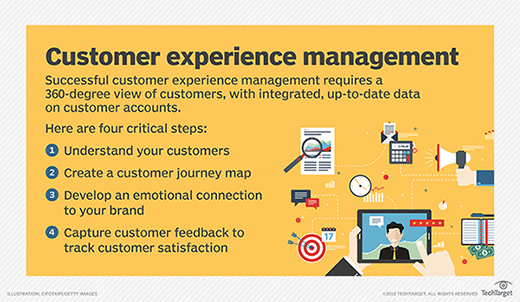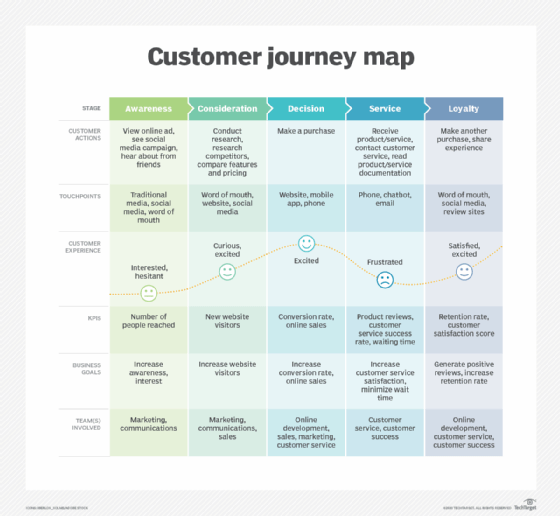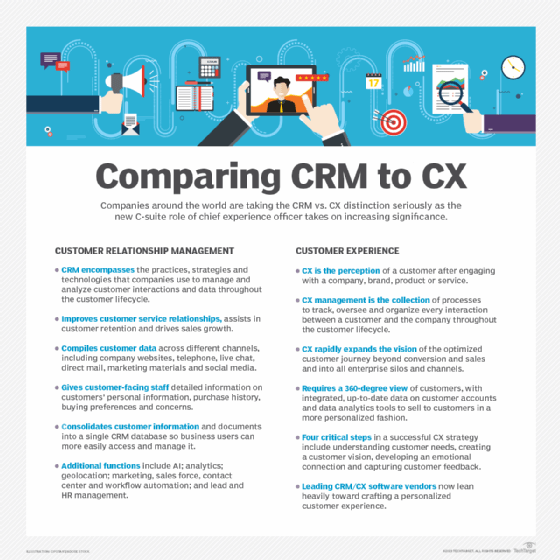What is customer experience management (CXM)? Ultimate guide
Customer experience management (CXM) is the collection of processes a company uses to track, oversee and organize every interaction between a customer and the organization throughout the customer lifecycle.
While many consider them synonymous, customer experience and customer service have key differences CX leaders must understand to achieve precision in their takeaways and best practices. Focusing on customer service to the detriment of the overall customer experience is a short-sighted view of the customer journey.
Why is CXM important?
Customer experience with a brand contributes to customer perceptions and sales. It can be positive when done well and negative when some elements of CXM are left unattended.
There are several benefits to implementing a CXM strategy:
- Customer retention costs less than acquisition. Studies indicate that a 5% increase in customer retention can result in a 25% increase in profit. This happens for numerous reasons, but mainly because a retained customer avoids the costs of acquiring a new customer, and satisfied customers tend to order more.
- Customer feedback drives improvement. Voice of the customer (VoC) data from web surveys, mobile app feedback, and phone and chat conversations provide a blueprint to improve customer experiences and retain customers.
- Happy employees project a better brand experience to the customers. Studies show a strong link between employee experience and customer experience. Companies with the best customer experience concentrate on measuring voice of the employee data to improve their experience and retention.
- Contented, loyal customers voluntarily endorse a company's brand to peers. Customer endorsement can often weigh more heavily in buying decisions than advertising or marketing efforts.
- Measuring customer sentiment yields information about competitors. Customers compare brands when making their decisions and offering feedback. Knowing this information can help a company position itself favorably against a rival.
What's the difference between CRM and CXM
While CXM may look similar to customer relationship management (CRM) strategy and software, there are key differences when comparing CRM vs. CXM, one being perspective: CRM shows what a customer looks like to the company, and CXM defines what a company looks like to the customer. CXM is a strategy that puts business customers at the center of marketing, sales and customer support to drive brand loyalty and repeat business.
CXM programs heavily rely on VoC programs that quantify customer sentiment about their experiences with a company. Over time, a CX management program will adjust elements of the customer experience that generate negative feedback to correct those perceptions.
CRM strategy, however, focuses on sales and outreach to customers from the company's perspective of capturing more revenue. Typically, this sales-oriented system -- which sometimes integrates with customer service and support -- requires major digital transformation to support an overall CXM program.
How to create a good customer experience
CXM requires companies to have a 360-degree view of customers, with integrated, up-to-date data on customer accounts. There are four critical steps to creating a successful customer experience strategy:
- Understand your customer. The first step in building a customer strategy is understanding customers' needs and behaviors. CX teams can develop customer profiles to understand how to market to target customers. Then they can implement customer segmentation based on age, interests and spending habits.
- Create a customer vision. Next, CX leaders should create a customer journey map. A customer journey map helps identify customer touchpoints and anticipate how customers interact with the product or service. Customer journey maps can often help CX teams boost customer retention in the long term.
- Develop an emotional connection. This involves creating a brand personality that evokes emotions and connections for a customer and helps establish a relationship between the customer and the company.
- Capture customer feedback. It is important to measure customer satisfaction in real time. Customer feedback can help the company track customer perceptions, enable quality monitoring and measure the success of the customer experience strategy.
Brands must assemble a CX team to execute those steps. CX teams include several roles, some new to many companies. These roles may include a chief customer officer, a chief experience officer and several CX managers. Analysts often report to the CX managers or executives to manage the data projects involved and act as a liaison between the CXM team and other departments -- such as marketing, customer service, sales and IT. Together, this team should monitor and develop a consistently improving customer experience.

What are some CXM challenges?
Eight main obstacles get in the way of good customer experience:
- Not enough voice of the customer data. A company can't accurately measure customer experience without large data sets and can't solve customer experience problems it doesn't know about.
- Lack of omnichannel support. When brands cannot listen to or help customers in the channels they are interacting with -- whether through email, social media, web chat, mobile apps or smart speakers -- customers can't make their wants and needs known. Customers who do not feel heard are more likely to switch to a competitor.
- Ignoring qualitative data. Brands should harvest and analyze individual comments in survey free-text fields, which can yield a deeper understanding of customer experience issues than numbered ratings can. Qualitative data can also give rise to new ideas for improving the overall experience.
- Poor internal communications. A CX team must do its homework by analyzing the customer journey, building VoC programs and collecting voice of the customer data to create better experiences. However, those initiatives won't work unless CX leaders distribute that information in an understandable way to stakeholders in sales, marketing, customer support and senior leadership.
- Organizational silos. An organization needs a complete view of customer behavior to understand them and their actions at relevant customer journey touchpoints. If sales and marketing have separate customer databases, CX teams work with insufficient data that can distort the reality of a customer's experience.
- Insufficient tools and technology. CX teams can only do so much if not given the right tools to gather and analyze customer data and implement changes based on those findings. A CXM platform can help respond to customer concerns in real time, measure customer loyalty, track the success of sales efforts and more, while a customer journey mapping tool can help draw insights from every customer interaction across web, mobile and physical channels.
- Outdated documentation. A customer's wants and needs will change with their circumstances. Gathering and analyzing extensive amounts of customer data is useless if that data isn't accurate and up to date. For CX teams to succeed, they must be able to rely on the data they're working from.
- Unclear ROI. The C-suite must justify the organization's commitment and investment to a CX strategy, and they won't be able to do that if they don't fully understand the ROI. Taking time to calculate CX ROI can go a long way to instilling confidence that the dedication of time and resources is worthwhile.
The customer experience journey
Chief experience officers are accountable for customer experience at every customer touchpoint with a company. Understanding why customer touchpoints matter is essential to boost satisfaction and drive growth. To find those touchpoints, draw a customer journey map, which reveals customers' many interactions with a brand. At a minimum, the map will have four sections:
- Research. The customer discovers a company, often on the web, via advertising or through third parties, such as consultants, colleagues or social media acquaintances.
- Comparison. Customers discover a brand's competitors and research user perception, functions, capabilities, cost and other attributes of all the competing products.
- Purchase. This part of the journey is the big business win, but it's just the beginning of customer retention and loyalty building.
- Support. The customer service and support teams that come into play after a sale are where loyalty and repeat sales begin. If these teams are poorly conceived, they can break the customer experience and send customers to competitors.
A key component of building effective customer journey maps is the development of customer personas. Once a company knows the main archetypes of its customer base from developing smart market segments, it can plug the typical personas into the journey map to show how to personalize content and the customer experience for each persona.
While businesses can build their customer journey map, several customer journey mapping tools can help streamline the process. These tools can help track key customer journey KPIs so CX leaders can identify what isn't working and adjust.

Customer experience management techniques and strategies
Understanding and managing customer experience requires CX professionals to become experts in skills like honing their strategic outlook or working in a data-driven mindset. Anyone looking to start a career in customer experience or learn about the latest CX trends should consider attaining a customer experience certification to get recognition for their expertise.
Managing customer experience along the entire customer journey requires the following:
- Generating content. Supporting research, marketing pieces and sales enablement content will give each team ways to prove value to customers. To take that a step further, brands should consider personalizing customer-facing content -- from emails and text messages to website content and mobile apps -- to improve relevance and customer engagement.
- Evaluating customer sentiment. CX teams should collect voice of the customer data throughout the entire journey to identify where to improve experiences. It's not enough to have that data; brands should understand customer emotions through customer sentiment analysis tools and techniques.
- Creating customer personas and marketing segments. Different groups of customers have different needs. Brands should build a consistent, engaging experience by addressing and anticipating customer needs.
- Investing in customer loyalty programs. Frequent customers want acknowledgment with savings and perks; customer loyalty programs deliver that. Well-executed programs drive up-sell revenue as well.
- Evaluating customer touchpoints. A brand needs to know where its customers make their purchasing decisions -- and when they are most likely to flee to its competitors -- to continually refine their customer experience.
- Analyzing customer data. Chief experience officers must work through VoC data with customer analytics tools to iterate constant improvements based on customer feedback.

Customer data privacy and security
Security breaches continue to grow in frequency and severity, and high-profile cybersecurity attacks keep customer privacy prominent in the minds of everyone who shares their personal information. As organizations gather and store more customer data, they must ensure that data remains protected and comply with privacy policies and laws.
CX teams can start by making CX security core to their overall strategy. It's up to every member of a CX team to mitigate the threat of data breaches by following best practices for customer data privacy. These practices include but aren't limited to deploying a data governance strategy, establishing and implementing cybersecurity policies, ensuring data is encrypted and protected, and continuously training employees.
How to choose the right CXM software
A customer experience management strategy isn't complete without the appropriate technologies to support it. Many cloud software vendors, such as Salesforce, Microsoft, Oracle and SAP, have platforms to manage the customer experience from end to end. These platforms center around four major components:
- CRM. A CRM is crucial for sales and marketing agents to access and manage customer information. It generally pulls data in from various channels and touchpoints, preventing customers from needing to repeat information.
- Marketing automation. Marketing automation software increases marketing efficiency and eliminates repetitive tasks. Marketing automation tools can include lead management, customer segmentation and campaign management.
- E-commerce. An e-commerce platform enables companies to build an online storefront with capabilities such as checkout, product catalogs and integration with payment processing.
- Customer service. Most CXM platforms offer a way for customer service teams to communicate with customers through omnichannel interactions. Some platforms also provide self-service, allowing customers to solve their problems via chatbots, product documentation and other options.
Other customer experience management platforms -- from vendors such as Adobe, Pegasystems, Episerver and Acquia -- offer integrated parts of the customer experience stack. These vendors are often adept in one or a few parts of the digital experience -- Adobe for marketing, customer analytics and e-commerce; Pegasystems for process management, customer service and more -- but weak or incomplete in other areas. Using these platforms often requires a mixed-vendor environment to complete the customer experience technology stack. Incidentally, that's a more common configuration than the single-vendor shop.
Some companies may benefit from building their customer experience technologies from a foundation of software they're already using. For example, a manufacturing company that tracks its international supply chain and distributors with an SAP ERP system may find integrating SAP customer experience tools more straightforward than starting from scratch with another vendor.
Other important customer experience tools include the following:
- Personalization engines. A foundational technology for customer experience programs beyond sales and service tools are personalization engines, which automate communications to customers on a one-to-one basis. Personalization strategies include new technologies, such as mobile marketing, location-based services and beacons, which help companies identify where customers are and market to them in real time. Sometimes, the data can help companies give consumers pointed information that may or may not be related to a discrete purchase. For example, a stadium might use location-based services to inform consumers which concession stand is proximal and less busy. Personalization is important for all companies, but more so for companies with large numbers of customers that stretch beyond the human staff's capacity to tailor personal messages and offers.
- Automation tools. Artificial intelligence can improve CX in areas other than marketing. AI automation tools can be a boon to managing customer experience by quickly performing low-level tasks so humans in customer service and fulfillment can concentrate on solving more complicated issues.
- Contact center software. Contact centers handle all outbound and inbound calls, but modern call center software goes beyond that, integrating speech analytics, advanced reporting and call routing.
- Voice of the customer software. VoC software extracts customer data from all channels, integrating with a company's contact center and digital interactions to create a nuanced view of customers' feelings and feedback.
- Emotional analytics. These tools gauge whether customers benefit from their interactions with the brand. Emotional analytics software can help analyze the success of various operations that are related -- but potentially tangential to -- customer service, such as inventory management or supply chain management.
- Knowledge management. These systems are also important tools for seamless customer service. Agents can use knowledge management systems to look up product information and customer interactions with other products. Agents can also combine this information with customer data and inventory information to provide customers with account information, product education and inventory.







